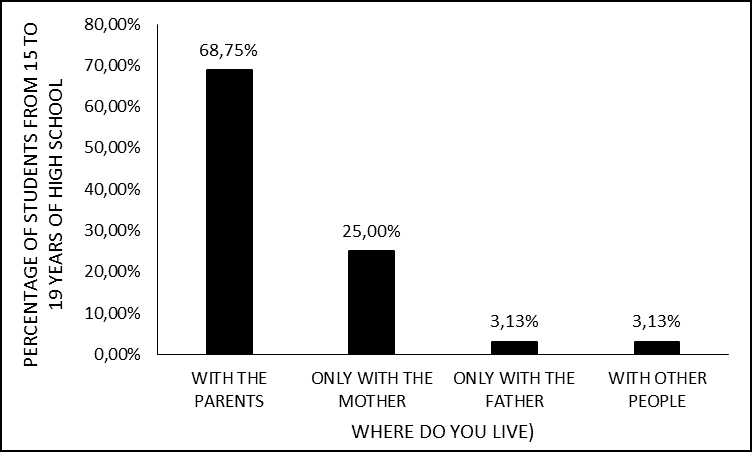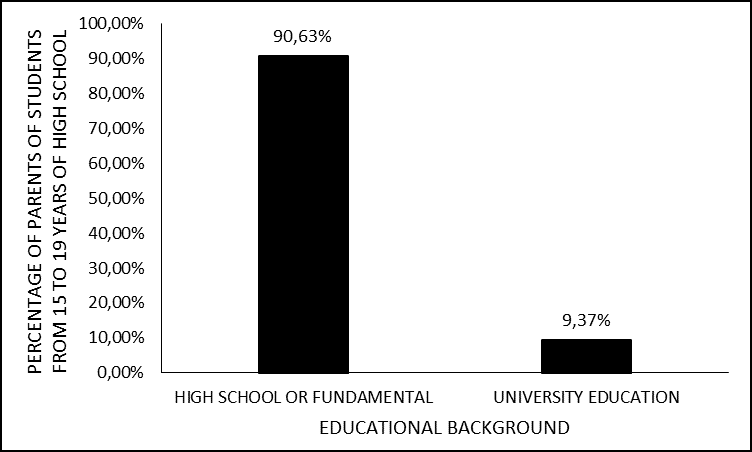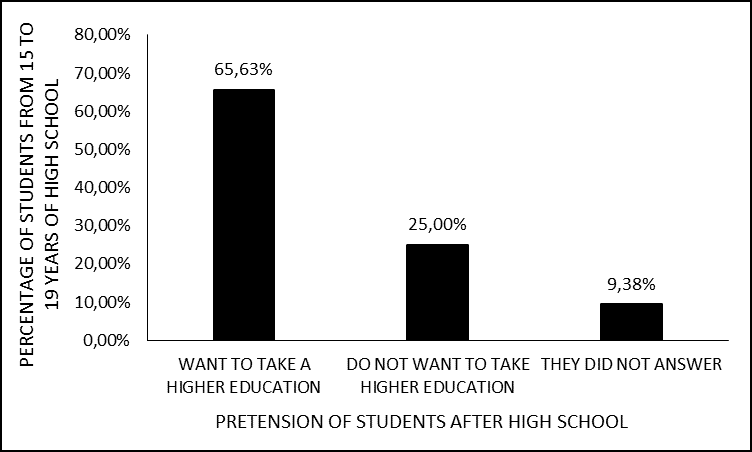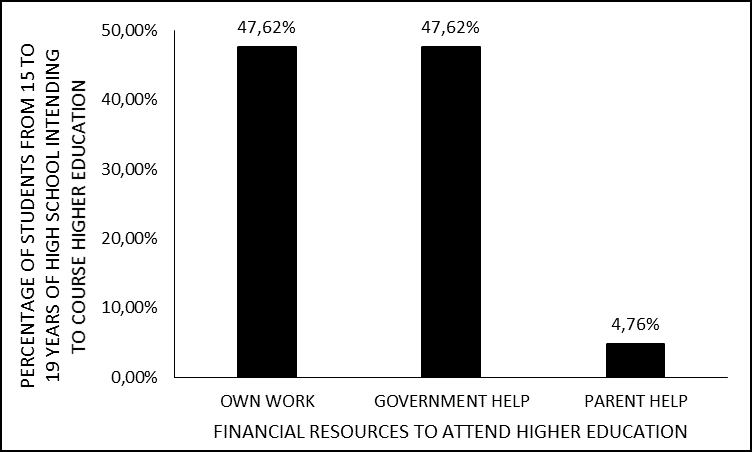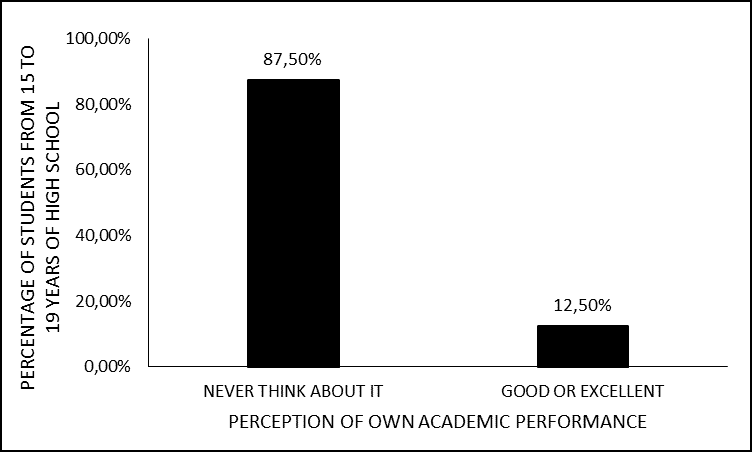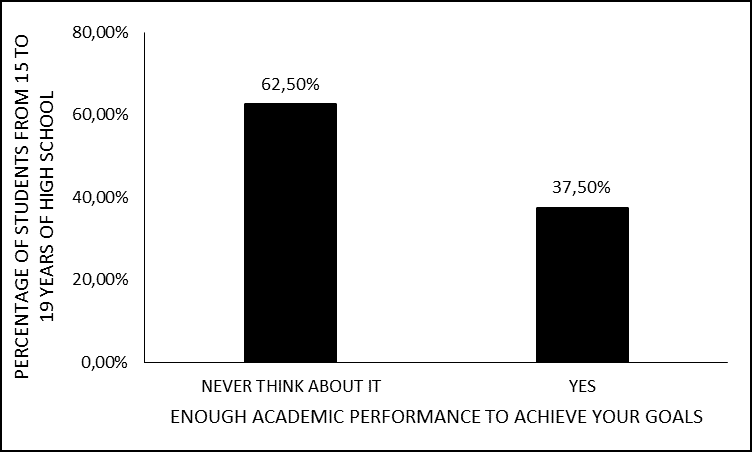ORIGINAL ARTICLE
DENDASCK, Carla Viana [1], FACCO, Lucas [2], FECURY, Amanda Alves [3], OLIVEIRA, Euzébio de [4], DIAS, Cláudio Alberto Gellis de Mattos [5]
DENDASCK, Carla Viana. Et al. Expectations, perceptions and motivations of students at a Public School of High School in Brazil. Revista Científica Multidisciplinar Núcleo do Conhecimento. Year 05, Ed. 05, Vol. 13, pp. 32-43. May 2020. ISSN:2448-0959, Access link in: https://www.nucleodoconhecimento.com.br/education/motivations-of-students
ABSTRACT
The achievement goal theory seeks to understand the set of factors, such as: thoughts, beliefs, motivations, purposes and emotions that lead the development of the individual’s performance (in this case, the students) to act, and, consequently, to translate into their results actions. The objective of this research was to investigate the expectations, perceptions and motivations of students from a public high school in the interior of São Paulo. The qualitative and quantitative study was carried out in a public high school, located in a city in the interior of the State of São Paulo, in the first semester of 2019. The separation of parents can sometimes be a problematic factor for student life. Students whose parents have literacy and longer formal education tend to remain literate and evolve in the educational field. High school students seek to complete their studies and move on to higher education in order to achieve personal life goals. A large proportion of students do not understand the real role of attending school.
Keywords: Limiting beliefs, socioeconomic inequality, achievement goal theory.
INTRODUCTION
The word believe is characterized as a direct transitive verb that means to believe as true, even if something proves otherwise. A negative belief can cause a cognitive construction, understanding and, consequently, behaviors capable of impacting the achievement goals of an individual or a group (SOUZA, 2010).
The achievement goal theory (1970) arising from the motivation theory for achievement, proposed by McClelland (1953) and Atkinson (1957), seeks to understand the set of factors, such as: thoughts, beliefs, motivations, purposes and emotions that lead the development of the individual’s performance (in this case, the students) to act, and, consequently, to translate their actions, or tasks, into results, whether in their emotional, cognitive aspects that will be translated into their results and / or performance (ZENORINI et al., 2011).
According to Santos et. al, (2011) and Zenorini et. al, (2013), beliefs directly influence the goal for achievement, and consequently, act on the motivation of individuals to perform their functions and / or incline to better learning, and, develop self-determination (OLIVEIRA and CATÃO, 2017 ).
The goal of motivation and self-determination comes from the belief that the individual is capable of accomplishing everything imposed on him, providing him with positive performance capacities, since the individual believes that his performance depends on his effort, preventing, or making it difficult for him to external aspects can provide them with some kind of obstacle (BUENO et al., 2007).
Although the achievement goal theory is widely used in the teaching-learning context (CARDOSO and BZUNECK, 2004; BUENO et al., 2007; OLIVEIRA and CATÃO, 2017), it is believed that its definitions directly influence the positioning, results and paths that individuals will go through after leaving the school context, either professionally or personally.
High school students can be characterized as teenagers and / or young people who are undergoing physical, intellectual and psychological transformation. It is also at this stage that they end up making decisions that tend to delimit much of their lives (PEREIRA et al., 2020). The social aspects and cultural factors that permeate the environment around the individual will also be largely responsible for providing them with subsidies on the paths they choose, and also on the paths they will actually take (SILVA, 2019).
AIM
To investigate the expectations, perceptions and motivations of students from a public high school in the interior of São Paulo, within the concepts of goal and achievement theory.
METHOD
The qualitative and quantitative study was carried out in a public high school, located in a city in the interior of the State of São Paulo, in the first semester of 2019. The questionnaire is part of a program of lectures on behavior, perspectives and life project conducted by the researcher that focuses on low-income students. This program is funded by the Research and Advanced Studies Center – CEPA, and works through lectures that are offered free of charge in public schools.
A questionnaire was applied with 5 questions aimed at understanding the socioeconomic profile of students, and open questions based on the goal and achievement theory questionnaire used by Bueno et al, (2007) and Zenorini et. al, (2011), with adaptation of vocabulary and language according to the profile of the students. All students and / or parents signed a free and informed consent form regarding the use of the data, and confidentiality of the students’ identity.
RESULTS
Figure 1 shows the percentage of students aged 15 to 19 from high school in a public school. The majority (68.75%) live with both parents. Those who live with their mother alone are 25%; only with the father 3.13%; and with other people 3.13%.
Figure 1 Shows the percentage of students aged 15 to 19 from high school in a public school.
The percentage of educational background of parents of students aged 15 to 19 years of high school in a public school appears in figure 2. Most parents have elementary or high school (90.63%) while the minority has higher education (9.37 %).
Figure 2 Shows the percentage of educational background of parents of students aged 15 to 19 years of high school in a public school.
The predominant professions of people who live with students aged 15 to 19 years of high school in a public school can be seen in figure 3. The three most frequent professions are auxiliary, butcher and painter (18.75% each), followed respectively per %); painter and driver (9.37% each); machine operator (6.25%); and by caretaker, farmer, retired, domestic worker, and self-employed (3.12% each).
Figure 3 Shows the predominant professions of people who live with students from 15 to 19 years of high school in a public school.
Figure 4 shows the percentage of students aged 15 to 19 years of high school in a public school, due to the intention of studying after high school. The majority intends to pursue higher education (65.63%) while the minority admits that they do not want to continue their studies in higher education (25.00%). Few did not answer this question (9.38%).
Figure 4 Shows the percentage of students aged 15 to 19 years of high school in a public school, due to the intention of studying after high school.
The percentage of students aged 15 to 19 years of high school in a public school who intend to pursue higher education, due to the financial resources used for this purpose, is shown in figure 5. The majority intend to count on their own work resources or to have support government programs (47.62% each). The minority intends to count on the help of the family (4.76%).
Figure 5 Shows the percentage of students aged 15 to 19 years of high school in a public school who intend to pursue higher education, by the financial resource used for this purpose.
Figure 6 shows the percentage of students from 15 to 19 years of high school in a public school and the perception of their academic performance. The majority stated that they had never thought about the subject (87.50%), while the minority said they recognized their performance as good or excellent (12.50%).
Figure 6 Shows the percentage of students aged 15 to 19 from high school in a public school and the perception of their academic performance.
The percentage of students aged 15 to 19 years of high school in a public school and their perception of whether their academic performance is sufficient to achieve their goals is shown in figure 7. Most students say they have never thought about it (62.50%). The minority says they have already worried about this issue (37.50%).
Figura 7 Mostra a porcentagem de estudantes de 15 a 19 anos do ensino médio uma escola pública e sua percepção sobre se seu desempenho acadêmico é suficiente para atingir seus objetivos.
DISCUSSION
One of the issues that are brought up for discussion as an important factor in the young person’s school performance is the issue of separation from parents and the impact this can have on the student’s life. This process can trigger a reduction in its performance, since, sometimes, the student’s perception and interest in classes is significantly reduced (MOREIRA, 2010). Another factor to be taken into account in this situation is the way in which the parents divorce. In the case of a conflictive separation, the student may be even more affected by having to deal with her outcomes (SOUZA, 2014). In view of this, the perception of the teacher is also important, because if he perceives the change in student behavior associated with negative emotions (such as sadness), he may be able to intervene early in the situation and alert those responsible for it, in addition to providing the student with the support he can (SANTOS and ROIM, 2014).
One of the factors that influence the student’s education is the level of formal education of the parents. According to the national household sample survey – PNAD – of 2014, in the Social Occupational Mobility axis, it was found that (among people aged 16 and over, who lived with their father when they were 15 years old) how much older is the rate of literate parents, the lower the number of illiterate children (IBGE, 2016). Therefore, it is noted the importance of parents in the students’ learning process, since they exert influence over them (ALMEIDA, 2014).
In order to favor the completion of basic studies and the entry of students into higher education, consequently helping their insertion in the adult environment, parents exercise the function of encouraging their children’s reflection on the choice of their future professions, in addition to investing in the processes educational activities according to their possibilities and in the best possible way. If there is an awareness that the student must make his / her choices independently about his / her future undergraduate course after completing high school, in addition to the profession he / she wants to follow, as well as the presence of constant dialogues and mutual understanding, the educational process of the young student tends to be more successful (ALMEIDA and MELO-SILVA, 2011). Students’ choice of profession is usually linked to the family’s professional axis, and sometimes the wishes and expectations of parents and guardians tend to have a positive influence on their choices. However, there must be an understanding of the student’s need to express their own wills, autonomously, without negative coercion about their choices (SOARES-LUCHIARI, 1996; OLIVEIRA, 2012).
In order to satisfy their educational and socioeconomic needs, students look for the will to pursue higher education after high school in the idea of personal fulfillment. For this task to be performed, it is necessary that the student has motivation and commitment (ANDRADE, 2012). The student’s motivation can be intrinsic or extrinsic. The first comes from the individual’s inherent will to achieve a dream or goal. The second is related to the environments frequented by the individual and the influence of the people who are close to him, usually his family (mainly parents), his friends and others. In the same way, however, there can also be demotivation, which is also determined by the same two facets (intrinsic and extrinsic), and in a situation of broad demotivation, the student tends not to advance in the pursuit of his goals, remaining stagnant (SOUZA and REINERT, 2009; CARVALHO, 2018).
In Brazil, it is possible to notice a fateful duality of the educational system: On the one hand, we have students from private schools, usually with more favorable conditions for teaching – with better infrastructure, financial resources and qualified teachers – and, on the other, students from public schools. , which tend to have more precarious infrastructure and lack other important characteristics. These factors culminate in the disparity in education, and, at a competitive level, private school students tend to be better prepared. Another factor to be taken into account is the entry of students in more fragile socioeconomic conditions at an earlier stage into the labor market. This insertion in the labor environment before the conclusion of basic education, having to deal with both responsibilities (educational and economic), even if it helps in social insertion and psychic maturation, can negatively influence the student performance of the young student, which may lead to the abandonment of the student. urge to enter the next educational level, higher education, and this decision can impact the future economic success of this young person, since he may later have difficulties to evolve at the labor level (DUTRA-THOMÉ et al., 2016; OLIVEIRA, 2018).
For the student to present good educational performance, several factors are necessary, such as intrinsic and extrinsic motivation and others, such as school resources (SOUZA and REINERT, 2009; DUTRA-THOMÉ et al., 2016). However, these requirements are not always present and, therefore, can negatively affect student performance. An example of a factor that can generate this negative situation is the demotivation of teachers, due to the stagnant and bankrupt educational structure, lack of continuing education and training, in addition to the unsatisfactory remuneration they receive. In addition, the educational institution itself (in view of the excessive valuation of students with better results and at the expense of others, causing exclusion within the teaching environment itself) can be a demotivating factor for the student (BEZERRA, 2014).
Even though they attend classes and try to achieve grades, many high school students, especially in public schools, do not understand the real reason for going through this training process. The fact that they do not understand these reasons leads to disregard with the daily study, thus leading to low learning of the proposed contents. Sometimes, the main factors that lead several students of this type of teaching to attend classes are the friends made in the school environment and the intention to have a professional career years later (MELO and LEONARDO, 2019).
CONCLUSIONS
The school is located in a region where it has slaughterhouses and clothing stores, which justifies the high rate of appointment of workers in these sectors, which it believes is not normal in other regions.
Parental separation can sometimes be a problematic factor for the young student’s student life, as he ends up losing focus and interest in the content proposed during classes.
Students whose parents have literacy and longer formal education tend to remain literate and evolve in the educational field. Thus, it is possible to note that family influence is often an important factor for students’ educational level.
The student’s academic, as well as professional, choice tends to converge to the family’s work history, and the student can reflect on home influences to choose his own training path. However, although they should advise and provide all possible support for the young person to reach their goals and dreams, the family should not exert pressure for the student to follow a certain path, as this can generate conflicts between the student and the family, in addition to, possibly impair the individual’s future satisfaction with his professional life.
High school students seek to complete their studies and move on to higher education in order to achieve personal life goals, be they social, economic, professional or any other. However, demotivation, whether intrinsic or extrinsic, can lead the student to stagnation, impairing the achievement of such goals.
The lack of school infrastructure, such as poor qualification of teachers, and lack of educational resources, especially in public education, can be demotivating factors for students in basic education, increasing the possibilities of dropping out of education.
A large proportion of students do not understand the real function of attending school, even though they are convinced that it is necessary for them to achieve the goals they have set for themselves. Because of this meager understanding of the purpose of teaching, they often do not engage as they should in daily study, a factor that triggers possible educational deficits in students.
REFERENCES
ALMEIDA, E. B. A relação entre pais e escola: a influência da família no desempenho escolar do aluno. 2014. 48p. (Graduação). Faculdade de Pedagogia, Universidade Estadual de Campinas, Campinas SP.
ALMEIDA, F. H.; MELO-SILVA, L. L. Influência dos pais no processo de escolha profissional dos filhos: uma revisão de literatura. Psico-USF, v. 16, n. 1, p. 75-85, 2011.
ANDRADE, J. Educação superior: uma abordagem de motivação e necessidade. 2012. Disponível em: < https://administradores.com.br/artigos/educacao-superior-uma-abordagem-de-motivacao-e-necessidade >. Acesso em: 23 maio 2020.
BEZERRA, M. C. L. Dificuldades de aprendizagem e os fatores que influenciam o fracasso escolar. 2014. 53p. (Especialização). Universidade Estadual da Paraíba, Itaporanga PB.
BUENO, J. M. H. et al. Investigação das propriedades psicométricas de uma escala de metas de realização. Estud. psicol., v. 24, n. 1, p. 79-87, 2007.
CARDOSO, L. R.; BZUNECK, J. A. Motivação no ensino superior: metas de realização e estratégias de aprendizagem. Psicol. Esc. Educ., v. 8, n. 2, p. 145-155, 2004.
CARVALHO, F. A. N. Impacto da relação entre família e escola no desempenho acadêmico do aluno. Revista Científica Multidisciplinar Núcleo do Conhecimento, v. 12, n. 8, p. 111-139, 2018.
DUTRA-THOMÉ, L.; PEREIRA, A. S.; KOLLER, S. H. O desafio de conciliar trabalho e escola: características sociodemográficas de jovens trabalhadores e não-trabalhadores. Psicologia: Teoria e Pesquisa, v. 32, n. 1, p. 101-109, 2016.
IBGE. Mobilidade sócio-ocupacional: Pesquisa Nacional por Amostra de Domicílios. Rio de Janeiro RJ: IBGE, 2016.
MELO, L. C. B.; LEONARDO, N. S. T. Sentido do ensino médio para estudantes de escolas públicas estaduais. Psicologia escolar e Educacional, v. 23, p. 1-9, 2019.
MOREIRA, F. P. A. A influência da separação dos pais no desempenho escolar de alunos das séries/anos iniciais na visão do professor. 2010. 55p. (Graduação). Universidade do Extremo Sul Catarinense, Criciúma SC.
OLIVEIRA, C. T. Participação no desenvolvimento de carreira dos filhos: visão dos genitores. Santa Maria RS, 2012. Disponível em: < http://www.unicap.br/jubra/wp-content/uploads/2012/10/TRABALHO-34.pdf >. Acesso em: 23 maio 2020.
OLIVEIRA, D. M.; CATÃO, V. Teoria das metas de realização em sala de aula e as possíveis influências nos padrões motivacionais para a aprendizagem da química em duas turmas do ensino médio. Góndola Enseñ Aprend Cienc, , v. 12, n. 2, p. 50-68, 2017.
OLIVEIRA, R. O ensino médio e a precocidade do trabalho juvenil. Educar em Revista, v. 34, n. 67, p. 177-197, 2018.
PEREIRA, S. G. et al. Desinteresse dos estudantes do 3° ano do Ensino Médio pela profissão de professor na Cidade de Patos de Minas – MG. Revista Científica Multidisciplinar Núcleo do Conhecimento, v. 2, n. 3, p. 121-137, 2020.
SANTOS, D. D. M.; ROIM, T. P. B. A interferência da separação familiar na aprendizagem infantil. Revista Científica de Ciências Aplicadas da FAIP, v. 1, n. 2, p. 1-9, 2014.
SILVA, M. A. D. C. Influência da cultura na educação. Revista Científica Multidisciplinar Núcleo do Conhecimento, v. 11, n. 10, 2019.
SOARES-LUCHIARI, D. H. Os desejos familiares e a escolha profissional dos filhos. Revista de Ciências Humanas, v. 14, n. 20, p. 81-92, 1996.
SOUZA, L. F. N. I. D. Estratégias de aprendizagem e fatores motivacionais relacionados. Educ. rev., n. 36, p. 95-107, 2010.
SOUZA, S. A.; REINERT, J. N. Motivação para entrada e permanência nos cursos de graduação em administração da Universidade Federal de Mato Grosso do Sul. XXXIII Encontro da ANPAD – EnANPAD. São Paulo SP: EnANPAD 2009.
SOUZA, S. D. C. Divórcio dos pais e dificuldades na aprendizagem dos filhos: a importância da família no processo de ensino-aprendizagem. 2014. Disponível em: < http://editorarealize.com.br/revistas/cintedi/trabalhos/Modalidade_1datahora_14_11_2014_11_26_41_idinscrito_2758_8115825674dc52b43ba4c6cd32a24452.pdf >. Acesso em: 23 maio 2020.
ZENORINI, R. D. P. C.; SANTOS, A. A. A. D.; MONTEIRO, R. D. M. Motivação para aprender: relação com o desempenho de estudantes. Paidéia, v. 21, n. 49, 2011.
[1] Theologian, PhD in Psychoanalysis, researcher at the Research and Studies Center Advanced – CEPA.
[2] Student of the Medical Course at the Federal University of Amapá (UNIFAP).
[3] Biomedical, PhD in Topical Diseases, Professor and researcher of the Medical Course at Campus Macapá, Federal University of Amapá (UNIFAP).
[4] Biologist, Doctor in Topical Diseases, Professor and researcher of the Physical Education Course at, Federal University of Pará (UFPA).
[5] Biologist, PhD in Theory and Research of Behavior, Professor and researcher of the Graduate Program in Professional and Technological Education (PROFEPT), Institute of Basic, Technical and Technological Education of Amapá (IFAP).
Submitted: May, 2020.
Approved: May, 2020.
